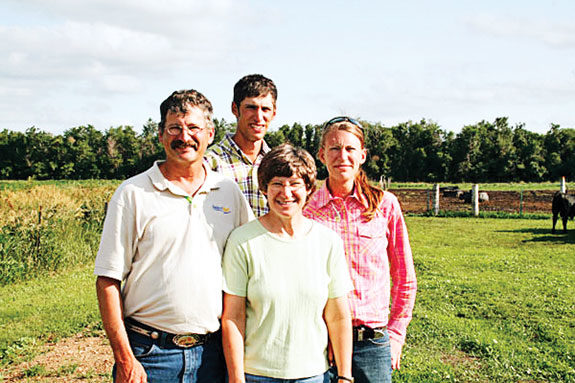Here amongst the James River Valley and the Coteau Hills, the family of Jim and Karen Kopriva, along with son, Lee, and daughter, Angela, raise seedstock and commercial Angus cattle on a nearly 2,000-acre spread of pasture and grazing lands.

In their region of South Dakota, the Koprivas are on the cutting edge of conservation efforts and grazing management.
For their forward-thinking initiative, the family was awarded the Leopold Conservation Award in 2012.
This award is given annually in South Dakota to ranchers and land stewards who embrace conservation efforts and the land ethic of renowned ecologist and land advocate Aldo Leopold.
Unlike many of their neighbors, the Koprivas have worked against the grain over the span of several years to convert the majority of their croplands back into grasslands for grazing and haying purposes.
The seed for this dynamic change in land use was planted in the mid-1980s, when Jim Kopriva attended a holistic management workshop sponsored by the Savory Institute.
At the time, Jim was working full-time as a loan officer. In the early 1990s, the Kopriva family moved to northeastern South Dakota, with Jim transitioning into full-time farming. Initially, the operation consisted of a diversity of enterprises, including grain crops, hay and cattle.
Over time though, driven by several economic factors, the family’s deep love of cattle, and a desire to conserve, sustain and improve the natural resources under their management for future family generations, the land conversion process and desire to implement new and better management strategies took shape and continues to this day.
All along, the Koprivas have maintained an open mind when it comes to making management decisions and are always on the lookout for new ideas that may offer ways to improve upon their current practices.
The majority of land formerly in crops has been converted over to grassland, with approximately 130 acres still used for crop production.
Much of these hay acres are maintained as pure alfalfa stands. At about 3 to 5 years old, these stands begin to thin slightly.
To maintain a high level of forage production, forages such as orchardgrass or Italian ryegrass are interseeded into stands to increase tonnage.
Tactics such as prescribed burning have been employed to establish new native grass seedings on the cropland pastures.
This practice allows new native grass seedlings to get an adequate start while reducing pressure from weeds and early cool-season grasses, like smooth bromegrass, a commonality that has misplaced many native species across much of the Great Plains today.
In addition, use of rotational grazing has also allowed for a noticeable shift in the plant biological community with natural re-introductions of many native warm-season species where there previously were none.
Remaining cropland follows a no-till rotation of spring wheat/winter wheat/soybeans, with cover crops no-tilled into the wheat stubble.
The use of cover crops in their rotation has allowed the Koprivas to not only build the health of their soils but also provide extended grazing into the winter months.
Crop residue from neighboring row crop farmers is also utilized for late fall and winter grazing.
Kopriva Angus plans to expand their use of cover crops in the years ahead by forming partnerships with local grain farmers to allow them to plant and graze cover crops on their grain fields.
This situation provides a win-win for both the farmer and the grazier, leading to improved soil health for the crop farmers’ fields and a source of additional grazing for the Koprivas’ herd and wildlife.
Along with the changes in land use, the Koprivas have adapted their grazing management from a continuous to rotational grazing system, allowing them to increase the ranch’s grazing capacity by nearly 50 percent.
Son, Lee Kopriva, describes the former system of grazing, saying “Gates were left open and pastures received very little rest.”
Some management changes as simple as closing gates behind cattle have led to significant increases in forage production.
Resting areas of pasture increases root reserves, making the grass stronger and thicker. Higher stocking rates encourage cattle to eat even the species of lesser palatability and young weeds.
This higher stocking and brief resting keeps grasses in the vegetative stages and keeps the nutritional value of the pasture higher longer and allows for quicker recovery, especially after a rain.
The improvements in land health seen through these management changes have in turn brought with them a plethora of additional benefits. Wildlife populations, especially birds, have increased.
During the summer grazing season flies are less of an issue for livestock; cattle are moved at least once a week, sometimes more often.
Economic benefits have also been seen, such as the reduction in use of harvested feed from extending the grazing season and grazing crop stubble and cover crops. Plans in the future include moving calving dates from early to late spring in May and June.
Kopriva Angus’ goal is to produce hardy cattle that can survive on the forage resources their environment provides while simultaneously improving the state of the natural resources under their management.
With this continued focus, they will be able to not only sustain but improve their operation for future generations of their family. FG
Bussard is a freelance writer based in Bozeman, Montana.
PHOTOS
FIRST: The Kopriva family (from left to right) front: Jim and Karen, back: Lee and Angela.
SECOND: Replacement heifers at Kopriva Angus grazing native warm- season grass pasture.
THIRD: Cover crops not only improve soil health, but provide extended grazing for the Koprivas’ cattle herd. Field corn was planted as a cover crop following wheat and served as a winter forage source.
FORTH: Jim Kopriva standing in a pasture that was seeded back to native warm-season grasses. Photos courtesy of Jesse Bussard.











